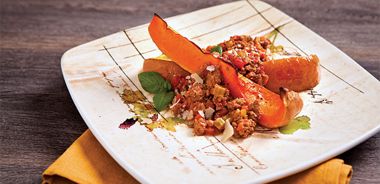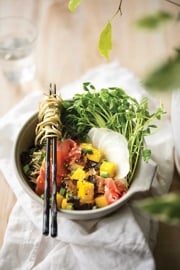Spicy Turkey Ragu Bolognese

A traditional Italian ragu is commonly made with red meat and treated with white wine. We break from tradition to make an amazing turkey ragu simmered with red wine. Delicious spooned over wedges of baked squash, rice, or quinoa.
2 Tbsp (30 mL) extra-virgin olive oil
2 Tbsp (30 mL) unsalted butter
1 large sweet onion, very finely diced
4 carrots, very finely diced
4 celery stalks, very finely diced
2 large garlic cloves, finely minced
2 lb (1 kg) lean organic ground turkey
1 cup (250 mL) dry red wine
2 cups (500 mL) milk
1 - 28 oz (796 mL) can diced tomatoes and their juice
1 cup (250 mL) low-sodium turkey or chicken stock
1 Tbsp (15 mL) cider vinegar
1 tsp (5 mL) each oregano, ground cumin, crushed chilies, and brown sugar
Salt and freshly ground black pepper
Shaved Parmesan cheese
Fresh basil
Heat oil and butter in large heavy saucepan. Add onion, carrots, celery, and garlic; sauté over medium heat until soft, about 7 minutes. Increase heat to medium-high and add half the ground turkey and sauté until crumbly and no pink remains. Add remaining turkey and continue to sauté, stirring often until crumbly and no longer pink.
Continue to sauté, slightly caramelizing the meat and evaporating any pan liquids, about 10 minutes. Stir often and reduce heat to medium if necessary.
Add wine and deglaze pan, stirring to dislodge any crumbled dark bits in bottom of pan. Continue to cook, stirring steadily to evaporate wine, about 2 minutes. Add milk, tomatoes with juice, stock, vinegar, and seasonings. Bring to a boil.
Reduce heat to low and, keeping lid ajar, simmer ragu for 2 hours or longer, or until sauce is completely thickened and no liquid remains. Add salt and pepper to taste. Stir often near the end of simmering to prevent sticking.
Serve ragu on wedges of baked butternut squash for a new twist. Top with shaved Parmesan cheese and fresh basil.
Makes 8 cups (2 L) or 8 servings.
Each serving contains: 322 calories; 26 g protein; 15 g total fat (5 g sat. fat, 0 g trans fat); 17 g total carbohydrates (7 g sugars, 3 g fibre); 335 mg sodium
What is deglazing?
Deglazing involves pouring a little cold liquid into a hot pan that’s been used to brown meats and vegetables. This is where much of the flavour resides. The liquid will sizzle up. Then use a wooden spoon to scrape the caramelized bits loose and stir them into the recipe.
source: "Cooking With Wine", alive #376, February 2014





